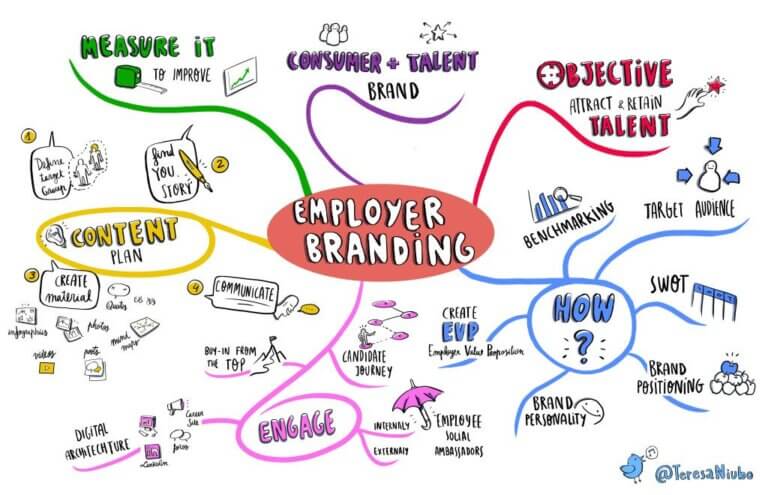Every company has a story. Think back to when you first started. The early days, when your team was small, and the hours were long. Now, look at where you are. You have a great group of employees who are helping you continue that story.
Telling your company’s story is important for your employer brand. Talent wants to see your company’s culture. The best way to show them is by providing them with employee and workplace stories that provide a glimpse of what makes you special.
You don’t need to be a skilled marketer to tell your story; you just need a bit of creativity. Staying up to date on what is successful and what works for your network, will help you attract new hires.
There are many ways you can use content to draw attention to your company that go beyond simple job postings and company updates.
The challenge lies within deciding what story you would like to tell and how you are going to tell it.
Types of employee stories that get the attention of talent
Employee and workplace stories are great types of content to use when you want to humanize your brand. Stories define and bring life to your employer brand. They help you attract talent by taking away the corporate aspects of your brand and leaving what matters: the people.
Here are a few common types of stories to get you started.
The job profile gives your network insight into different positions within your company. It can be presented as a typical “day in the life” of one of your employees. This story outlines the responsibilities that your employees have. It is a fun exercise for employees to undertake because it allows them to show your audience what they are most proud of. They get to brag about all the exciting aspects of their job, which is great testimonial for your company.
A culture profile looks at the attitudes, behaviours, and values of your company. Events and traditions showcase your company’s attitudes and behaviours. Try capturing stories about your events and traditions. Posts like these can help attract talent because they can see if their values align with yours.
The employee spotlight is a fun post for your employees to get involved with. For this type of story, you can start with a list of fun semi-personal questions for your employees to answer. It gives them the chance to share their passions with their co-workers, and the company’s network.
The team profile showcases the efforts your team has taken to overcome a work-related challenge. It puts the spotlight on culture by showing how teams work together in your company and also can be used to show the types of technical challenges that one could expect.
It is important to be authentic within these stories because you are opening a door to your company from the outside world. Allow your employees to be transparent in their responses. Talent will recognize your humility as a company.
Employee and workplace stories, regardless of their type, are beneficial when it comes to boosting employee morale and employer brand.
Telling your stories where talent will see them
Once you have decided which types of stories you would like to tell, you need to decide how you would like to deliver them.
Sometimes content can be delivered entirely within a social media post. Using an employee story for a quick update on your social channels is a creative way to get the attention of your network. Take your employee and workplace stories and add photographs, videos, or emojis to enhance their visibility. The point of these posts is to give a taste and then drive traffic to your career page where talent can get more information about your workplace and culture. So, don’t forget to include a link to get them there.
Be aware that each platform has character limits that will limit the length of your story. Even though some platforms, like Facebook, allow for longer updates, but it is best to make your stories concise when posting on social media. Your network may be more apt to read a condensed, highlighted version of a workplace profile while scrolling through their socials.
If you want to produce a longer story or profile, consider using a blog post. Companies often use employee blogs associated with their career pages to provide talent with a greater understanding of who they are and what makes them the right choice. If you can’t host a blog on your career page, you could use a third-party website like Medium.
Long-form articles are best for detailed stories. Short, bullet point articles, like listicles, can be used as quick filler pieces that break down certain aspects of your stories, and provide information in a quick, digestible manner.
Like your social media posts, you are going to want to create a call-to-action. How this looks, will be dependent on which platform you are hosting your blog on. If you post your blog to your careers page, it will be very simple to direct talent to your job openings, and more information about your company’s culture. If you are hosting your blog on a third-party site like Medium, you may need to add copy at the end of your blog that suggests a call-to-action.
Regardless of where you post your blog, it is important that when you do, you update your network about the latest posting on your social media accounts.
Videos are another medium you can use to help increase engagement within your social media channels. According to worldstream.com, “Video drives a 157% increase in organic traffic from search engine results pages.”
Like blogs, videos can be used to expand on the stories you tell in your social updates. Explainer videos are a good type of video to use when you want to provide your viewers with a visually appealing run-down of your company’s ins and outs. Explainer videos don’t just tell; they show talent what it is really like to work at your company. They let viewers in on your perspectives because it will make them feel as though they are already a part of the team. They can be added to short social media posts on most platforms, to provide colour and more information about specific facts, which may include company numbers and achievements. Videos allow talent to see what they are investing in.
Creating successful employee stories does not require you to consistently create perfect content and social media posts. What separates your content from the rest, will be your ability to commit to a rhythm that responds to the needs of your company and keeps you in front of your network.
If you are able to commit a little bit of time each month to creating employee stories, you will be well on your way to creating engaging content that attracts the right hires for you.







